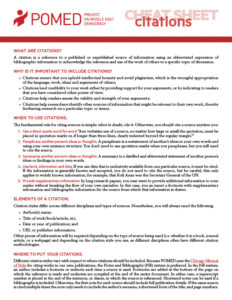For an English PDF of this quick read, click here.
For an Arabic PDF of this quick read, click here.
 WHAT ARE CITATIONS?
WHAT ARE CITATIONS?
A citation is a reference to a published or unpublished source of information using an abbreviated expression of bibliographic information to acknowledge the relevance and use of the work of others to a specific topic of discussion.
WHY IS IT IMPORTANT TO INCLUDE CITATIONS?
- Citations ensure that you uphold intellectual honesty and avoid plagiarism, which is the wrongful appropriation of the language, work, ideas and arguments of others;
- Citations lend credibility to your work either by providing support for your arguments, or by indicating to readers that you have considered other points of view;
- Citations help readers assess the validity and strength of your arguments;
- Citations help researchers identify other sources of information that might be relevant to their own work, thereby furthering research on a particular topic or issues.
WHEN TO USE CITATIONS.
The fundamental rule for citing sources is simple: when in doubt, cite it. Otherwise, you should cite a source anytime you:
- Use a direct quote, word-for-word: “Any verbatim use of a source, no matter how large or small the quotation, must be placed in quotation marks or, if longer than three lines, clearly indented beyond the regular margin.” [1]
- Paraphrase another person’s ideas or thoughts: A paraphrase is a restatement of another’s ideas in your own words and using your own sentence structure. You don’t need to use quotation marks when you paraphrase, but you still need to cite the source.
- Summarize another person’s ideas or thoughts: A summary is a distilled and abbreviated statement of another person’s ideas or findings in your own words.
- Use facts, information and data: If you use data that is exclusively available from one particular source, it must be cited. If the information is generally known and accepted, you do not need to cite the source, but be careful, this only applies to widely known information, for example, that Kofi Anan was the Secretary General of the UN.
- Provide supplementary information: In long research papers, you may want to provide additional information to your reader without breaking the flow of your own narrative. In this case, you an insert a footnote with supplementary information and bibliographic information for the source from which that information is drawn.
ELEMENTS OF A CITATION.
Citation styles differ across different disciplines and types of sources. Nonetheless, you will always need the following:
- Author(s) name;
- Title of work/book/article, etc;
- Date or year of publication; and
- URL or publisher information.
Other pieces of information will be required depending on the type of source being used (i.e. whether it is a book, journal article, or a webpage) and depending on the citation style you use, as different disciplines often have different citation methodologies.
WHERE TO PUT YOUR CITATIONS.
Different citation styles vary with respect to where citations should be included. Because POMED uses the Chicago Manual of Style for citing works in our own publications, the Notes and Bibliography (NB) system is preferred. In the NB system, an author includes a footnote or endnote each time a source is used. Footnotes are added at the bottom of the page on which the reference is made and endnotes are compiled at the end of the entire document. In either case, a superscript number is placed at the end of the sentence, or clause, in which the source is referenced. Shortened notes can be used if a bibliography is included. Otherwise, the first note for each source should include full publication details. If the same source is cited multiple times the note only needs to include the author’s surname, a shortened form of the title, and page numbers.
CITING DIFFERENT TYPES OF SOURCES.
There are many different citation styles, each corresponding to different disciplines. Because POMED uses the Chicago Manual of Style for citing works in our own publications, it is presented here, however, social science researchers also often use the American Psychological Association, or APA Style. While the choice of citation style is ultimately the researcher’s, it is important to be consistent and use the same style each time. Chicago-style citation formats for the most commonly used research materials follow. For information about how to cite other types of materials, please contact a member of POMED’s Civil Society Partnerships team.

Format: Author’s Name (First Last), Book Title (Publishing City: Publisher, Year), Page Numbers.
Example: Edward W. Said, Orientalism (New York: Random House, 1979), 125-129.

Format: Author’s Name (First Last), “Chapter Title,” in Book Title, ed. Editor’s Name (First Last) (Publishing City: Publisher, Year), Page Numbers.
Example: Driss Maghraoui and Saloua Zerhouni, “Morocco,” in The Middle East, ed. Ellen Lust (Thousand Oaks: CQ Press, 2017), 674-706.

Format: Author’s Name (First Last), “Article Title,” Journal Name Volume number, issue number, (Month, Year): Page Number. [2]
Example: Morris P. Fiorina, “An Outline for a Model of Party Choice,” American Journal of Political Science 21 no. 2 (April, 1977): 601-625.

Format: Author’s Name (First Last), “Article Title,” Journal Name Volume number, issue number, (Month, Year): Page Number. DOI or URL. [3]
Example: Barry Gills and Joel Rocamora, “Low Intensity Democracy,” Third World Quarterly 13, no. 3 (1992): 507. https://doi.org/10.1080/01436599208420292. [4]

Format: Author’s Name (First Last), “Article Title,” Publication Name, Date, Page Number or URL.
Example: Andrew Miller, “Tunisia is one of the Arab world’s biggest success stories. The Trump administration doesn’t seem to care,” The Washington Post, March 15, 2018, https://www.washingtonpost.com/news/democracy-post/wp/2018/03/15/tunisia-is-one-of-the-arab-worlds-biggest-success-stories-the-trump-administration-doesnt-seem-to-care.

Format: Author’s Name (First Last), [5] “Page Title,” Website Title, Publisher, last modified [INSERT DATE], [6] URL.
Example: “Lebanon,” Data, The World Bank, accessed May 9, 2018, https://data.worldbank.org/country/lebanon?view=chart.
NOTES
1. “When to Cite Sources,” Academic Integrity, Princeton University, last modified August 2017, https://www.princeton.edu/pr/pub/integrity/pages/cite/.
2. In a note, include a specific page number. In the bibliography, include the page range for the entire article (or chapter).
3. A DOI, or a Digital Object Identifier, forms a permanent URL to an article. This is preferable to a URL that appears in your browser.
4. Please note: if you are using a verbatim quote, list only the page number on which the quote appears. You may list the entire page range for the article (or chapter) in the bibliography.
5. If the author’s name is not available, you may skip directly to the page title.
6. If the most recent date of modification is not available, you may use the date on which you accessed the webpage.




|
President Trump is Undermining Foreign Aid Transparency and Accountability